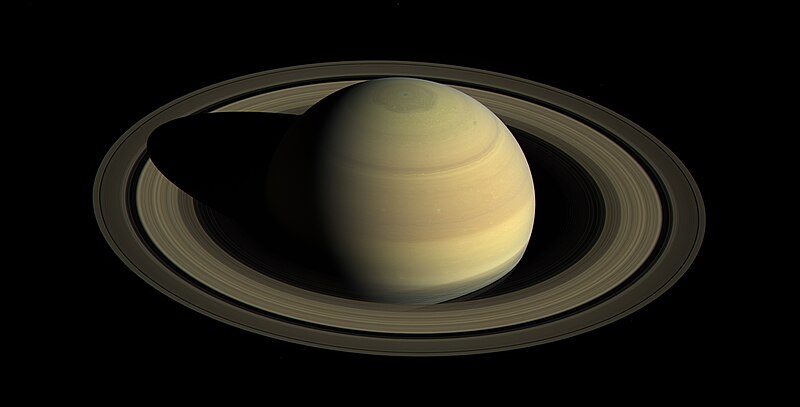File:8423 20181 1saturn2016.jpg

Orihinal na file (2,012 × 1,024 na pixel, laki: 555 KB, uri ng MIME: image/jpeg)
Captions
Captions
Buod[baguhin]
| Paglalarawan8423 20181 1saturn2016.jpg |
Since NASA's Cassini spacecraft arrived at Saturn in mid-2004, the planet's appearance has changed greatly. The shifting angle of sunlight as the seasons march forward has illuminated the giant hexagon-shaped jet stream around the north polar region, and the subtle bluish hues seen earlier in the mission have continued to fade. Earlier views obtained in 2004 and 2009 (see PIA06077 and PIA11667) demonstrate how drastically the illumination has changed. This view shows Saturn's northern hemisphere in 2016, as that part of the planet nears its northern hemisphere summer solstice in May 2017. Saturn's year is nearly 30 Earth years long, and during its long time there, Cassini has observed winter and spring in the north, and summer and fall in the south. The spacecraft will complete its mission just after northern summer solstice, having observed long-term changes in the planet's winds, temperatures, clouds and chemistry. Cassini scanned across the planet and its rings on April 25, 2016, capturing three sets of red, green and blue images to cover this entire scene showing the planet and the main rings. The images were obtained using Cassini's wide-angle camera at a distance of approximately 1.9 million miles (3 million kilometers) from Saturn and at an elevation of about 30 degrees above the ring plane. The view looks toward the sunlit side of the rings from a sun-Saturn-spacecraft angle, or phase angle, of 55 degrees. Image scale on Saturn is about 111 miles (178 kilometers) per pixel. The exposures used to make this mosaic were obtained just prior to the beginning of a 44-hour movie sequence (see PIA21047). The Cassini Solstice Mission is a joint United States and European endeavor. The Jet Propulsion Laboratory, a division of the California Institute of Technology in Pasadena, manages the mission for NASA's Science Mission Directorate, Washington, D.C. The Cassini orbiter was designed, developed and assembled at JPL. The imaging team consists of scientists from the US, England, France, and Germany. The imaging operations center and team lead (Dr. C. Porco) are based at the Space Science Institute in Boulder, Colo. For more information about the Cassini Solstice Mission visit http://ciclops.org, http://www.nasa.gov/cassini and http://saturn.jpl.nasa.gov. עברית: כוכב הלכת החיצוני שבתאי. |
| Petsa | Released: September 15, 2016 (PIA 21046) |
| Pinanggalingan | http://www.ciclops.org/view/8423/Saturn-Approaching-Northern-Summer |
| May-akda | Credit: NASA/JPL-Caltech/SSI |
Paglilisensiya[baguhin]
| Public domainPublic domainfalsefalse |
| This file is in the public domain in the United States because it was solely created by NASA. NASA copyright policy states that "NASA material is not protected by copyright unless noted". (See Template:PD-USGov, NASA copyright policy page or JPL Image Use Policy.) |  | |
 |
Warnings:
|
Tala ng orihinal na pagkarga[baguhin]
| Petsa/Oras | Sukat | Tagagamit | Komento |
|---|---|---|---|
| 2016-10-25 16:26:26 | 2012× 1024× | Fotaun | {{PD-NASA}} http://www.ciclops.org/view/8423/Saturn-Approaching-Northern-Summer Since NASA's Cassini spacecraft arrived at Saturn in mid-2004, the planet's appearance has changed greatly. The shifting angle of sunlight as the seasons march forward has... |
Nakaraan ng file
Pindutin ang isang petsa/oras para makita ang file noong puntong yon.
| Petsa/Oras | Thumbnail | Sukat | Tagagamit | Komento | |
|---|---|---|---|---|---|
| ngayon | 03:13, 14 Disyembre 2016 |  | 2,012 × 1,024 (555 KB) | FastilyClone (usapan | ambag) | Transferred from en.wikipedia (MTC!) |
Hindi mo mao-overwrite ang file na ito.
Paggamit sa file
Ginagamit ng sumusunod na 4 (na) pahina ang file na ito:
- Saturn
- File:כוכב הלכת החיצוני שבתאי.jpg (redirect ng file)
- Category:Saturn (planet)
- Category:Saturnian deities
Pandaigdigang paggamit sa file
Ginagamit ng mga sumusunod na wiki ang file na ito:
- Paggamit sa ar.wikipedia.org
- Paggamit sa ar.wikiversity.org
- Paggamit sa ary.wikipedia.org
- Paggamit sa arz.wikipedia.org
- Paggamit sa ast.wikipedia.org
- Paggamit sa ca.wikipedia.org
- Paggamit sa ckb.wikipedia.org
- Paggamit sa crh.wikipedia.org
- Paggamit sa diq.wikipedia.org
- Paggamit sa el.wikipedia.org
- Paggamit sa en.wikipedia.org
- Pioneer 11
- Voyager 1
- Voyager 2
- Christiaan Huygens
- Saturn
- Cassini–Huygens
- Huygens (spacecraft)
- Timeline of Cassini–Huygens
- Template:Saturn spacecraft
- Exploration of Saturn
- Titan Saturn System Mission
- Kronos (spacecraft)
- Titan Mare Explorer
- Saturn's hexagon
- List of missions to the outer planets
- Titan Lake In-situ Sampling Propelled Explorer
- AVIATR
- Saturn Atmospheric Entry Probe
- Cassini retirement
- Enceladus Life Finder
- Journey to Enceladus and Titan
- Life Investigation For Enceladus
- Enceladus Explorer
Tingnan ang karagdagang pandaigdigang paggamit sa file na ito.
Metadata
Naglalaman ang file na ito bg karagdagang impormasyon na posibleng dinagdag mula sa digita na kameta o sa scanner na ginamit o nag-digitize dito. Kung nabago ang file mula sa orihinal na estado nito, posibleng hindi maipakita ang ilang mga detalye sa nabagong file.
| Pamagat ng larawan | IDL TIFF file |
|---|---|
| Lapad | 2,012 px |
| Taas | 1,024 px |
| Mga bit (piraso) ng bawat komponente (bahagi) |
|
| Plano ng kumpresyon (pagkakasiksik) | Walang kompresyon |
| Mga taglay (komposisyon) ng piksel | RGB |
| Oryentasyon | Karaniwan |
| Bilang ng mga komponente (sangkap) | 3 |
| Pahalang na resolusyon (kalinawan) | 100 dpi |
| Patayo na resolusyon (kalinawan) | 100 dpi |
| Pagkakaayos ng mga dato | pagkaayos sa malalaking bahagi (chunky) |
| Ginamit na sopwer | Adobe Photoshop CS6 (Macintosh) |
| Petsa at oras ng pagbabago ng talaksan | 17:06, 14 Setyembre 2016 |
| Espasyo ng kulay | Hindi nakaakma sa pamantayang sukat |
| Petsa at oras ng pagsasadihital | 09:42, 14 Setyembre 2016 |
| Petsa kung kailang huling binago ang metadato | 10:06, 14 Setyembre 2016 |
| Natatanging ID ng orihinal na kasulatan | xmp.did:018011740720681183D1E578F599C4C0 |